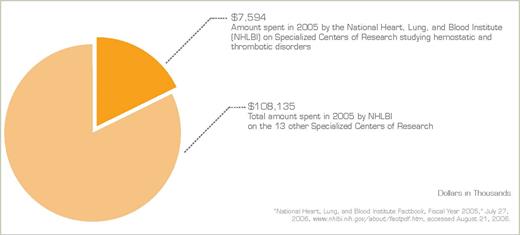By some estimates, nearly 900,000 Americans each year suffer a serious venous thromboembolic (VTE) event - deep vein thrombosis (DVT) and/or pulmonary embolism (PE). Despite significant knowledge of important risk factors, such as surgery, trauma, hospitalization for medical illness, cancer, and advanced age, annual death rates from VTE exceed those for myocardial infarction and stroke combined. These observations, along with high-profile cases such as the tragic death in Iraq of TV newsman David Bloom from PE, the emergence of effective patient advocacy groups, and continued ASH education and advocacy efforts, have caught the attention of national leadership in public health and medical research. Over a five-week span this spring, two workshops were held in Washington on the subject of VTE.
In early May, the Surgeon General’s office and the National, Heart, Lung, and Blood Institute (NHLBI), jointly sponsored a workshop addressing the key issues of inadequate use of effective prevention protocols in hospitalized patients, insufficient public awareness of VTE, insufficient research investments in critical areas of pathophysiology, and the role of specific therapies, such as new catheter-directed “mechanico-lytic” approaches to ileofemoral DVT. The workshop also focused on building partnerships among the various groups to develop strategies to address these issues in a logical and coordinated manner. It is our hope that as a result of this meeting the Surgeon General’s office will issue a report and recommendations on VTE. The meeting was attended by approximately 75 individuals with a wide range of interests and expertise, including former Surgeon General, Richard Carmona, MD, and the Director of the NHLBI, Elizabeth Nabel, MD, as well as program staff from NHLBI and the Office of the Surgeon General, VTE patients, national spokespeople Melanie Bloom and Mark Jablonski (President of National Alliance for Thrombosis and Thrombophilia), health services and clinical thrombosis researchers, and physicians from multiple specialties, including vascular and trauma surgeons, radiologists, hematologists, pulmonologists, cardiologists, and gynecologists. Among the group were several ASH members, and I attended as the designated ASH representative.
One month later, a smaller workshop organized and sponsored by ASH focused on the narrower topic of venous thrombosis in the elderly. The group was surprised to find the clear correlation illustrated in the graph — that incidence rates of VTE increase dramatically at about age 55 and by age 75-80 are ~1000-fold higher than for those aged 45 or less. The group was charged to identify important clinical and research questions related to this poorly understood association. Discussion was spirited and deep, and the goal to identify gaps in current knowledge and establish a list of priorities that might form the basis for future research and training opportunities was successfully met. A detailed report is being prepared by participants with hope that findings will be presented at a future ASH annual meeting. I had the privilege to chair this meeting, which was held at ASH Headquarters in Washington and was attended by 25 leading experts in thrombosis, including those from the clinical research, basic research, and health services/clinical epidemiology communities. We were joined by a group of outstanding geriatric researchers and by program staff from NHLBI, NCI, the National Institute of Aging (NIA), and the Office of the Surgeon General. Sessions were led by Russell Tracy from the University of Vermont (epidemiology of VTE in the elderly), Charles Esmon from Oklahoma Medical Research Foundation (basic pathophysiology of VTE in the elderly), William Ershler from the Institute for Advanced Studies in Aging (geriatrics), and Ken Bauer from Harvard (diagnosis and therapeutics of VTE in the elderly).
The coincidental timing of the ASH workshop with an ongoing strategic planning process at NHLBI, the new interest in VTE by the Surgeon General’s office, and increasing interest in hematologic disorders in the elderly by NIA should help NIH develop a research plan for VTE and encourage cooperation among NIH Institutes to fund more research and training programs. ASH is pleased to be playing an important role in this process.


